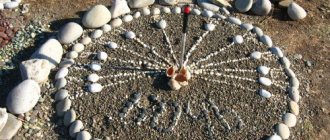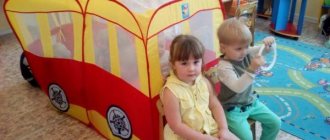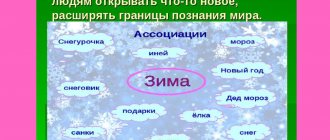Oksana Nikolaevna Polezhaeva
Card index of didactic games on ecology for children of senior preschool age
Card No. 1
“What do we take in the basket?”
.
Didactic task : to consolidate in children the knowledge of what crops are harvested in the field, in the garden, in the vegetable garden, in the forest.
Learn to distinguish fruits based on where they are grown.
To form an idea of the role of people in conservation of nature.
Materials: Pictures of vegetables, fruits, cereals, melons, mushrooms, berries, as well as baskets.
Progress of the game. Some children have pictures depicting various gifts of nature. Others have pictures in the form of baskets .
Children - fruits disperse around the room to cheerful music, with movements and facial expressions they depict a clumsy watermelon, tender strawberries, a mushroom hiding in the grass, etc.
Children - baskets must collect fruits in both hands. Necessary condition: each child must bring fruits that grow in one place (vegetables from the garden, etc.)
. The one who fulfills this condition wins.
Card No. 2
"Tops - roots"
.
Didactic task: teach children to make a whole from parts.
Materials: two hoops, pictures of vegetables .
Progress of the game. Option 1. Take two hoops: red, blue. Place them so that the hoops intersect. In the red hoop you need to put vegetables whose roots are used for food, and in the blue hoop you need to put those whose tops are used.
The child comes to the table, chooses a vegetable, shows it to the children and puts it in the right circle, explaining why he put the vegetable there. (in the area where the hoops intersect there should be vegetables whose tops and roots are used: onions, parsley, etc.
Option 2. On the table are the tops and roots of plants - vegetables. Children are divided into two groups: tops and roots. Children of the first group take the tops, the second - the roots. At the signal, everyone runs in all directions. To the signal “One, two, three – find your match!”
, you need to find your match.
Card#3
Ball game "Air, earth, water"
.
Didactic task: to consolidate children’s knowledge about natural objects . Develop auditory attention, thinking, and intelligence.
Materials: ball.
Game progress: Option No. 1. The teacher throws the ball to the child and names an object of nature, for example, “magpie”
.
The child must answer “air”
and throw the ball back.
To the word “dolphin”
the child responds
“water”
, to the word
“wolf”
-
“earth”,
etc.
Option No. 2. The teacher calls the word “air”
The child who catches the ball must name the bird.
For the word “earth”
- an animal that lives on earth;
to the word “water”
- the inhabitant of rivers, seas, lakes and oceans.
Card No. 4
"Guess what's in the bag?"
.
Didactic task: teach children to describe objects perceived by touch and guess them by their characteristic features.
Materials: vegetables and fruits of characteristic shapes and varying densities: onions, beets, tomatoes, plums, apples, pears, etc.
How to play: you know the game “Wonderful Bag”
, we will play differently today. Whoever I offer to take an object out of the bag will not immediately pull it out, but after feeling it, he will first name its characteristic features.
Card No. 5
"Nature and Man"
Didactic task: to consolidate and systematize children’s knowledge about what is created by man and what nature gives to man.
Materials: ball.
Progress of the game: the teacher conducts a conversation with the children, during which he clarifies their knowledge that the objects around us are either made by human hands or exist in nature, and people use them; for example, forests, coal, oil, gas exist in nature, but houses and factories are created by humans.
"What is made by man"
? asks the teacher and throws the ball.
"What is created by nature"
? asks the teacher and throws the ball.
Children catch the ball and answer the question. Those who cannot remember miss their turn.
Card#6
"Choose what you need"
.
Didactic task: to consolidate knowledge about nature. Develop thinking and cognitive activity.
Materials: subject pictures .
Progress of the game: object pictures . The teacher names some property or sign, and the children must choose as many objects as possible that have this property.
For example: "green"
- these can be
pictures of a leaf , cucumber, grasshopper cabbage. Or: “wet”
- water, dew, cloud, fog, frost, etc.
Card#7
“Where are the snowflakes?”
Didactic task: to consolidate knowledge about the various states of water. Develop memory and cognitive activity.
Materials: cards depicting different states of water: waterfall, river, puddle, ice, snowfall, cloud, rain, steam, snowflake, etc.
Relevance
Environmental problems encourage professionals in various fields of human activity to find new ways to reach the younger generation. Today it is very important to convey to children from early childhood the idea of the value of nature.
In order to form the rudiments of an ecological culture in a preschooler, adults need to show creativity, consistency and integrity. The most successful method for environmental education of preschoolers is play.
The world of toys and games today is diverse. These include computer, board, and story games. The game arouses interest in new information, charges with positive emotions, unites the children's team, brings adults and children closer together, teaches them to think and draw conclusions.
The purpose of environmental games is to teach preschoolers to respect nature and all living things. Below we will talk about what simple environmental games you can play with preschoolers.
Ecological games with analogue toys
Such games are very effective in kindergarten, as well as in the family with the participation of adults.
•Toy and live cat
Purpose of the game: talk about cats, teach the child to observe the behavior of a cat, to distinguish a living cat from a toy.
An adult gives the child a toy - a cat. Asks to describe the toy cat. What color is it? What are her paws like? Ears? Tail? You can feed her with toy food, put her to sleep, or sing a lullaby to the cat.
Then the adult shows the child a live cat. He asks to describe her and answer the same questions. What is the difference between a live cat and a toy cat?
The main difference is that a live cat is not a toy, it was given birth to by a mother cat, but a toy was made by people. A live cat should not be played with in the same way as a toy, as a live cat will feel pain, hunger, or may be frightened. In the process of such comparison, the child learns to recognize the signs of a living creature, take care of it and treat it with care.
•Toy and live spruce
Purpose of the game: talk about a living spruce, compare a living tree with an artificial one. In the second half of December, an adult shows the child a spruce tree in natural conditions. It's best to take a walk in the park or forest. There is snow on the paws of the spruce tree. Spruce is an evergreen coniferous plant. The child examines the paws of the spruce tree, its needles, and its trunk. You can take several photos.
In preparation for the New Year, an artificial spruce is used. An adult explains to a child that an artificial spruce is also beautiful in its own way. This is the beauty of the work put in by man. An artificial spruce can be decorated with lights and toys, and after the holiday, the toys can be removed and the spruce can be used at the holiday next year. A live spruce cut for the New Year holiday will die and be thrown away after the holiday.
The adult explains to the child that people can independently choose a live or artificial spruce for the holiday. By choosing an artificial spruce, the child preserves a living tree.
Visual aids and posters
Ecological games for preschoolers on a printed basis.
A child, together with an adult, can make a colorful poster or photo collage on a chosen environmental theme. For example, a poster on the topic: “Rules of behavior in the forest”, “How to behave while hiking”, “Don’t play with fire!”, “How to behave on a pond”, etc.
This poster contains short, informative captions for bright pictures. Hang such a poster in a kindergarten group or in a children's room. This way, the information will be easily remembered, and later it will become a good and cheerful memory of childhood!
Sport games
Today there is a large selection of didactic material on sale, using which you can come up with your own games.
The simplest ecological sports game can be considered the “edible-inedible” game. The presenter throws the ball to the child and says the word. If the word belongs to the category of “edible”, then the child must catch the ball; if the word does not mean an edible object, then the child must throw the ball away. Every time a child makes the right choice, he takes a step forward. The one from the group of children who reaches the leader the fastest wins.
The rules can be changed a little. For example, instead of edible and inedible, you can name edible - inedible mushrooms, forest and non-forest plants, domestic - wild animals, and so on.
This game allows the child to move around, carefully monitor the ball, and also provides an opportunity to apply and expand knowledge about the world around him.






